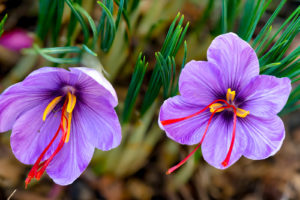Some of the earliest flowers to appear in the new year are from the genus Crocus. With careful management these bulbs can flower from September all the way to April, making them a valuable source of pollen and nectar for bees waking up from hibernation.

One species of crocus is particularly famous- Crocus sativus, the saffron crocus. The plant produces three stigmas (the pollen receiving part of the female reproductive sytem in a plant) that must be harvested by hand at mid-morning, when the flowers are open. These stigmas are the spice known as saffron. One flower yields around 7 mg of dried saffron so it’s no wonder that it is the most expensive spice in the world! Throughout its history it has been used as a status symbol in food, as a dye and in medicines (though there is no evidence of any medicinal properties). In the 14th century it was even thought to be effective against the Black Death and the theft of a shipment ignited a 14 week long war until it was returned.

What molecules are the cause of all this fuss?
There are three key molecules associated with saffron. Firstly, α-crocin (8,8-diapo-8,8-carotenoic acid), a water soluble carotenoid, is largely responsible for the pigmentation of saffron and its usefulness as a dye. Interestingly, Crocin is also the name GSK uses for one of its paracetamol formulations in India. Secondly, the glucoside picrocrocin, thought to add the bitter notes to saffron’s flavour and may also have some pesticide properties. During the drying process this molecule breaks down to yield safranal. Safranal is a volatile oil that is responsible for much of the aroma of saffron and has a less bitter flavour than picrocrocin. However it is very sensitive to fluctuations in pH and breaks down quickly in the presence of oxygen and light. Therefore, dried saffron should be stored in a protective environment, away from daylight, and used within a few weeks of being opened.


If it’s so expensive can I grow it myself?
Along with the labour intensive harvest and short shelf life, another factor contributing to saffron’s cost is the fact that it is infertile. The plants are triploids (i.e. have 3 sets of chromosomes) so chromosome pairing during meiosis is disrupted. This means they cannot reproduce sexually; instead they must be propagated by manual division of the corns. Triploidy is not uncommon among cultivated crops such as watermelons and Cavendish bananas because it means that they will not contain seeds. However, as a consequence, there is no genetic diversity which makes it quite possible that a single pathogen could wipe out the population if the plants became infected. Perhaps as a result of this, saffron crocuses are not present in the wild, but they are cultivated in many different countries. Originating in Iran, they need plenty of sunlight, well drained soil with high organic content and a good amount of rain. These days nearly all production is in the “saffron belt”, stretching from Spain to Kashmir but microscale production can also be found in the UK, USA, Australia and all the way north to Sweden. Why don’t you try growing your own saffron this year?
